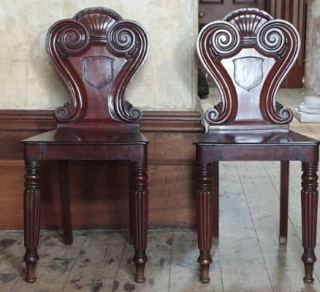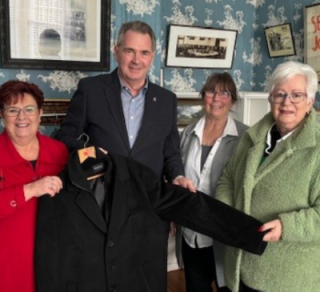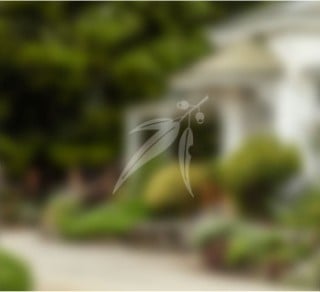Historic Longford House, the home of Andrew and Meredith Meeves will be the venue for this year’s National Trust Christmas cocktail party on Wednesday 27 November.
William Hardy Wilson (1881-1955), collotypes of Clarendon from his Old Colonial Architecture of New South Wales and Van Diemen’s Land (1924).
Longford House was built by Joseph Solomon in c1834. It belongs to the English Picturesque Movement taste for villas – architecturally sophisticated smaller houses sited in botanically-interesting gardens. Longford House’s entrance front features a modest Doric portico while its garden front features a bay window from which its residents could enjoy a parterre. The house’s features include wide eaves and tall casement windows as seen at nearby Woolmers Cottage.
In 1849, the house became Longford Grammar school. Subjects studied included Greek, Latin, geometry, astronomy, trigonometry, history, parsing and geography. Longford Grammar moved to Launceston in 1854. Longford House then became a girls’ school known as Longford House Establishment for Young Ladies. It was advertised as being for those “who were desirous of respectability being instructed in French, drawing, embroidery and music”. When Longford House was offered for sale in 1854, it was described as “a noble mansion, domain and garden. The edifice is handsome, extensive and commodious with every accommodation of offices, outhouses, prolific garden and wells of the purest water.”
William Hardy Wilson (1881-1955), collotypes of Longford House from his Old Colonial Architecture of New South Wales and Van Diemen’s Land (1924).
In 1862, the house with 74 acres (30 hectares) of land was acquired by William Pitt (1806-1891), an ex-convict from Bristol. Pitt had been assigned to evangelist and businessman, Henry Reed at Old Wesleydale at Chuddleigh. Reed gave Pitt the best possible take on Christianity – that Pitt should use his talents to do good for the community. This motivated Pitt to found the Longford show, local societies and provide flood relief for his neighbours. While Pitt amassed significant landholdings, his convict origins were known so he remained outside the local establishment.
Through William Pitt and his family, Longford House has associations with the National Trust’s Clarendon. When James Cox, grandson of Clarendon’s builder consigned Clarendon’s original contents to auction in December 1869, William Pitt purchased furniture, books and other items.
William had eight children. He left the property onto his second son, James, who had eleven children. The final Pitt family owners were James’ unmarried children, Strath and Mary. When the house was sold in 1991 after 129 years of Pitt family ownership, it didn’t have running water, flushing toilets or electricity as Mary (who died in 1985) had wanted it kept in original condition. Original Cox pieces remained at Longford House until dispersed in 1985. The Trust has purchased key items for Clarendon, most recently a pair of cast iron fire dogs in Egypto Revival taste c1830.
The architect, William Hardy Wilson (1881-1955), stayed with the Pitt family and produced collotypes of both Longford House and Clarendon for his Old Colonial Architecture of New South Wales and Van Diemen’s Land (published 1924). Clarendon’s double-storey portico had been removed in the c1870s-80s and Hardy Wilson referenced historic photographs to show the house in its original form. Such was the power of his image, that it led the National Trust to reinstate the portico in 1974. Hardy Wilson’s view of Longford House shows it with its romantic crumbling soft render finish and old china rose. How we would like to propagate that rose for both gardens!
To quote Stephanie Zhang from Australian Country Magazine,
“After 1991 Longford House passed through a succession of owners until Andrew and Meredith Meeves bought it in 2020. …Longford House’s grounds had good bones, with a parkland-style garden protected from the strong prevailing winds from the nearby Western Tiers by rows of cypress pines. It included an advanced wisteria walk, a quince walk and orchard. The Meeves have devoted considerable effort to restoring hawthorn hedges that surround the property and, during spring, delight in drifts of daffodils under the silver birches and a crabapple orchard that becomes a blaze of deep pink in spring and later is suffused with orange and yellow tones in autumn. They’ve added a parterre garden and fountains and thousands of flowering plants and trees including heritage roses and clematis, stands of lipstick maples for more autumn colour along with the ash, oak and elm trees. Andrew and Meredith say they don’t expect to see all the fruits of their gardening efforts. “We are custodians of the property and when it comes to planting slow-growing trees, you don’t do it for yourself,” Meredith says. “You do it for future generations to enjoy.”



